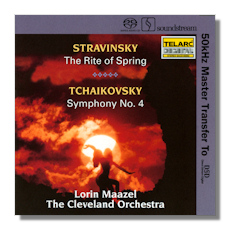
The Internet's Premier Classical Music Source
Related Links
- Latest Reviews
- More Reviews
-
By Composer
-
Collections
DVD & Blu-ray
Books
Concert Reviews
Articles/Interviews
Software
Audio
Search Amazon
Recommended Links
Site News
 SACD Review
SACD Review
Tchaikovsky / Stravinsky

- Piotr Ilyitch Tchaikovsky: Symphony #4
- Igor Stravinsky: The Rite of Spring
Cleveland Orchestra/Lorin Maazel
Telarc SACD-60563 Hybrid SACD 75:48
Do you own a Super Audio CD player? It is too soon to tell whether the Super Audio CD (or SACD) is a development no one asked for (think of the MiniDisc) or whether it is an innovation whose importance rivals that of the compact disc itself. A few record labels now are reissuing older material (some of it even pre-digital) in this format. Telarc already has over a dozen SACDs on the market. This one attracted my attention because I have conventional CD versions of both of these recordings. Maazel's Tchaikovsky is appealing and quite recommendable. His Stravinsky is much more willful (try the wildly idiosyncratic treatment of the chords at the start of "Glorification of the Chosen One"), but attention grabbing – it's a powerful performance.
The SACD was co-developed by Sony and Philips. The hybrid SACD, of which this is an example, has two layers. The bottom layer can be read by a conventional CD player. The top layer is what is read by an SACD player. This works because CD and SACD players use lasers of different wavelengths; the player automatically selects which layer to read.
Better early digital recordings, including these, were made using the Soundstream recording process. These recordings had a sampling rate (50kHz) that exceeded the 44.1kHz capacity of the standard 16-bit compact disc, so "down-sampling" had to occur. Down-sampling compromised the signal in various ways, although most people agreed that the results were still an improvement over what the previous norm had been. For the present CD layer, Telarc has sampled the original 50kHz Soundstream signal with Direct Stream Digital (DSD) technology, and the DSD signal has been down-sampled "optimally" to the CD sampling rate of 44.1kHz.
SACD players are not limited by the conventional 44.1kHz sampling rate; after encoding by DSD, the 50kHz signal, with no down-sampling, is available to the SACD player. (Higher sampling rates are possible too.) In theory, the result is an increased frequency response and the removal of artifacts attributed to down-sampling.
The DSD layer, in addition to stereo data, can include Multichannel data, and also non-musical information (text, graphics, and video). The present disc, as with the other Soundstream originals, contains only the stereo format because no other formats were recorded in 1979-80, when these recordings were made. Other Telarc releases, such as the new 1812 Overture with Erich Kunzel (SACD-60541) exploit the technology more fully.
I heard this SACD on a conventional CD player. Telarc claims that the hybrid SACD, even played in this manner, offers a sonic improvement from the original CDs. This is not immediately apparent. Then again, the sound was fabulous to begin with. I'd welcome the opportunity to hear this disc on an SACD player, but they hardly are common right now.
If you really have no intention of buying an SACD player, ever, it's probably OK to sit these hybrid discs out, unless it is the performance itself that interests you the most. (In that case, be prepared to pay good money for features you will not be using.) If, however, you think you might go down the SACD road in the future, you have nothing to lose by purchasing any stereo hybrid CD. I'm not sure where I stand right now. In 1985, I can remember saying I'd never jump on the CD bandwagon! Look where I am today.
Copyright © 2002, Ray Tuttle




















